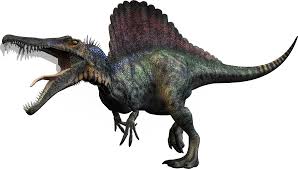Period: Late Cretacious
Order, Suborder, Family: Saurischia, Theropoda, Spinosauridae
Location: Africa (Egypt, Niger)
Length: 40 feet (12 meters)
In 1912, a German paleontological expedition discovered the remains of several new Late Cretaceous dinosaurs in Egypt. Spinosaurus, a large theropod, was one of the new dinosaurs. It got its name, which means “spined reptile,” because of the tall spines on its vertebrae (bones of the spine). Some spines are over five feet tall. They formed a sail along the animal’s back much like those of the Permian mammallike reptile Dimetrodon. It is interesting that an unrelated fin-backed dinosaur, the plant-eating ornithopod Ouranosaurus, has been found from nearly the same age in nearby North Africa. Two unrelated fin-backed dinosaurs in the same area may mean that the climate influenced the development of fin-backed animals. The fin may have been a thermal regulator, releasing heat on hot days and absorbing heat on colder days. It also may have been used as a display to attract members of its own species and scare other species.
Even though the skeleton is incomplete, Spinosaurus shows several other interesting features. It was a long theropod. The teeth are different from other theropod teeth because the serrations (the cutting ridges along the sides) were very small. Even more unusual is that the teeth were shaped like cones rather than blades. These tooth features, along with the shape of the skull bones, show that Spinosaurus is similar to Baryonyx. They may both belong in the family Spinosauridae. Spinosaurus may have eaten fish, but it is difficult to imagine such a large dinosaur catching enough fish to keep it alive. It more likely preyed upon land animals and fish.
The original skeleton of this theropod was destroyed in World War II. Recently, however, a piece of a skull bone belonging to another Spinosaurus was found on a shelf in a German museum. Perhaps another expedition to Egypt will uncover more skeletons so that we can learn more about Spinosaurus.



 October 17th, 2013
October 17th, 2013  Riffin
Riffin 
 Posted in
Posted in  Tags:
Tags: 